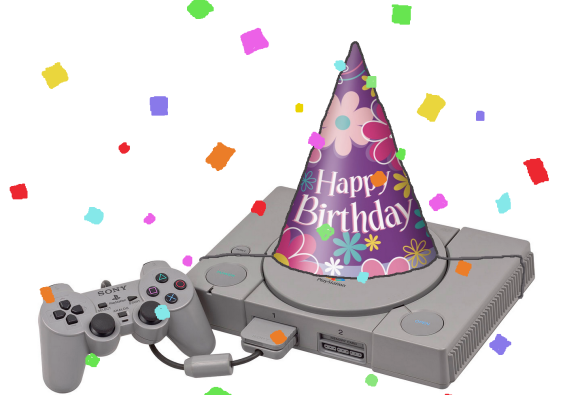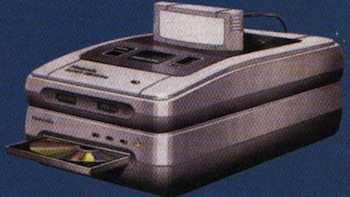
If you grew up in the ’90s, chances are the original PlayStation was a part of your life. Arriving on the console scene long after rivals Nintendo and Sega, PlayStation was an altogether different kind of beast. Its games shipped on CDs, it boasted spiffy three-dimensional graphics, and one of its flagship titles even featured music by abrasive electro pop group The Prodigy. It may have been a dull grey slab of plastic, but PlayStation was the console that all the cool kids wanted.
By some cruel trick played on us by the forces of nature, Sony’s original PlayStation turns 20 years old today. This makes us feel tremendously bitter and old, but at the same time we thought this would be a good opportunity to look back at some of the great games that came into being through the console, and also to revisit the surprisingly dramatic tale of how PlayStation was born.
Humble beginnings
The original PlayStation launched in Japan on December 3, 1994, but it’s fair to say that the seeds were planted as far back as the late ’80s when video game giant Nintendo began working with Sony to produce optical discs intended for the distribution of their software. Nintendo’s own disks, which were released only in Japan for the Famicom (NES) Disk System add-on, were prone to data loss and could be easily copied by consumers, so Nintendo hoped to use new-fangled CD-ROM technology, a field in which both Sony and fellow electronics maker Philips were already key players, to distribute its games in the coming years.
Forming increasingly closer ties, Nintendo ultimately signed a deal with Sony–who was by this time was also making audio chips for Nintendo–to produce a disc-based add-on for their Super Famicom (Super Nintendo Entertainment System in the West), extending the console’s lifespan and allowing it to compete with rival video game company Sega, who was also exploring CD technology. Nintendo also granted Sony permission to build a console of its own, dubbed the Play Station, that as well as supporting Sony’s new disc technology would be compatible with Nintendo’s proprietary game cartridges.
▼ The prototype image for the SNES add-on that would go on to become the stuff of legend
Alas, things did not go quite according to plan…
Trouble in paradise
With the hardware almost ready to go into mass production, Sony looked set to make its first foray into the video game industry, safe in the knowledge that it would be doing so with the help of the global market leader. At the 11th hour, however, Nintendo CEO Hiroshi Yamauchi got cold feet when he realised that the contract he had signed would give Sony significantly more power over software distribution than he had anticipated. Much to the company’s embarrassment, Sony was ditched by Nintendo in favour of Philips, with Nintendo breaking things off not through a series of boardroom meetings or awkward phone calls, but by publicly declaring that it would instead be working with the Dutch electronics company to bring its CD add-on to the world.
Sony, a company whose experience lay mainly in TVs, audio equipment and semiconductors, was now left red-faced and with a console that they could not legally take to market. Clutching at straws, they approached Sega in the hope of partnering with them and sticking it to Nintendo, but the gaming company reportedly scoffed at the idea of working with a group that had never released a single game or piece of gaming hardware as long as it had existed. Sony was on its own.
A question of space
Things were looking grim for Sony, but a man named Ken Kutaragi, the same Sony engineer who had singlehandedly developed the Super Famicom’s sound chip after–or so the story goes–being decidedly unimpressed with the original NES’s bleeps and bloops, pushed forward the notion that there was money to be made in the video game industry. Rather than scrapping the entire project and wasting thousands of hours of work, Sony’s bigwigs ultimately decided to make the best of a bad situation by launching PlayStation, as it had been rebadged, entirely on their own and going up against Nintendo. With the backing of then-CEO Norio Ohga, Kutaragi was tasked with making PlayStation a success.
Fortunately for Kutaragi, a decision later made by none other than new rival Nintendo helped PlayStation become a household name right out of the gate. Despite experimenting with the format and it being the very cause of the troubles between Sony and Nintendo, Nintendo’s CD-ROM add-on never saw the light of day. Instead, the games company pulled a complete 180 on the storage medium, citing long load times and–as later turned out to be painfully true–the ease with which CDs could be pirated as their reasons for not making the new format a part of their next console, the Nintendo 64, or Ultra 64 as it was then known.
But game developers were already very much in love with CDs. They allowed for vastly more data to be stored, making it possible to include things like pre-rendered backgrounds, full-motion video and high-quality voice samples in games. Not only that, CDs were markedly cheaper to make than Nintendo’s cartridges and were a format that consumers were becoming increasingly fond of and familiar with. Slow load times or not, developers such as Square and Enix (then entirely separate entities) urged Nintendo to ditch cartridges for optical discs, but Nintendo dug its heels in and vowed to stick with its existing format. As a result, a number of big-name software developers chose to cut ties with Nintendo, shifting development of their games to newcomer PlayStation, a console which had not only been built from the ground up with CD technology at its core, but whose creator was at that exact time aggressively courting software developers. Securing key titles such as Final Fantasy VII and Dragon Quest VII, both of which were originally destined for Nintendo’s next console, PlayStation suddenly became the only place to play a number of much-loved franchises, and fans took notice.
Commercial weirdness
Like Sega before it, Sony aimed to distance its console from Nintendo’s own by positioning it as something intended for more mature audiences. Taking advantage of its clout in the music business and numerous corporate connections, Sony wooed developers, recording artists and commercial makers alike, establishing Sony Computer Entertainment (a name that, notably, omitted all mention of the term “game” due to its slightly childish connotations) and building an altogether sexier and more mature public image for its console; one that its key demographic of teenagers and young adults would be enticed by.
PlayStation launched in Japan on December 3, 1994 and with its futuristic 3-D graphics and grown-up image was met with much fanfare. The console took almost a full year to reach North America and Europe, but by the time it, did Sony had already started bombarding the TV-viewing public with a series of bizarre ads (a strategy they would go on to employ once again in 2000 for the launch of PlayStation 2) that set tongues wagging and expectations high.
▼ The original PlayStation launch date teaser
▼ The console’s UK ads were equally odd. Heads up for the manic staring Scottish kid at 00:42.
▼ The “Society Against PlayStation” ads took a slightly different approach, at one point even showing an actor tossing the very product he’s selling into the bin.
Got game(s)
It was PlayStation’s software library, though, that was key to its success. Sony lacked a mascot to rival Nintendo’s Super Mario or Sega’s Sonic The Hedgehog, so instead aligned itself to be seen as home to the kind of content that older, more image-conscious consumers would be happy to associate themselves with or be seen to enjoy. As well as ports of arcade titles that pushed technological boundaries, games appeared on PlayStation which featured mature themes that would have seemed positively alien on Nintendo’s decidedly family friendly platforms.
We’re sure we would have eventually seen some of the following games on some console or other had Sony not decided to step into the ring, but it was thanks to their little grey box that we first got to experience some of these 32-bit gems:
▼ Capcom’s Resident Evil, complete with its now legendary ropey voice acting and live-action video.
▼ Straight from the arcades, 3-D fighter Tekken spawned a number of sequels and was one of PlayStation’s flagship titles. Developer Namco even slipped a watered-down version of Space Invaders into the game’s loading screen to keep impatient gamers entertained.
▼ You may have forgotten it existed, but Destruction Derby took our breath away back in the ’90s. There were bits actually falling OFF the cars!!!
▼ Psygnosis’ futuristic racer Wipeout had The Prodigy’s “Firestarter” as one of its background music tracks. Enough said.
▼ Riiiiidge Raaacer! How did that woman holding the placard not get mowed down at the start of every race?
▼ Free to shove as much game data as they liked onto the disc, Square brought us the now iconic RPG Final Fantasy VII
▼ Metal Gear Solid was one of the first truly “mature” titles many gamers ever played, and featured hours of cinematics and expertly voiced dialogue. It even had credits appearing during the opening level.
▼ Grotesquely proportioned as she once was, would the gaming world be the same without Tomb Raider’s Lara Croft?
Despite its unlikely beginnings, PlayStation went on to take an enormous chunk out of Nintendo’s share of the console market, and spawn a number of successors and the brand, as we know, is still going strong. By the time it was discontinued in early 2006, more than 102 million units of the original console had been sold worldwide, and in many countries “PlayStation” had become a generic term for the box under your TV that plays video games. Not bad, as we’re sure Sony would agree, for the little console that got dumped at its first prom.
Happy 20th birthday, PlayStation. Your younger siblings might have smarter graphics, online capabilities and controllers that lack the long lengths of cable required to make the spaces between our couches and TV sets veritable death traps, but your blocky, awkward graphics, that weird ticking noise you sometimes used to make, and, yes, even your frequent disc read errors will always have a special place in our hearts.
Feature image Wikipedia/All You Need To Party, edited by RocketNews24


 Newsflash: Sony unveils “Project Morpheus”, new virtual reality headset for PlayStation 4
Newsflash: Sony unveils “Project Morpheus”, new virtual reality headset for PlayStation 4 Countdown to PlayStation 4 in Japan – Mr. Sato heads to the Sony Building to join the fun
Countdown to PlayStation 4 in Japan – Mr. Sato heads to the Sony Building to join the fun Nintendo might be using Android to power its next games console
Nintendo might be using Android to power its next games console PlayStation 3 gets a price cut in Japan, still costs more than it probably ought to
PlayStation 3 gets a price cut in Japan, still costs more than it probably ought to Pretend you’re Sony or Nintendo as you devour Sega with Tokyo’s new Sega Logo-yaki sweet
Pretend you’re Sony or Nintendo as you devour Sega with Tokyo’s new Sega Logo-yaki sweet McDonald’s new Happy Meals offer up cute and practical Sanrio lifestyle goods
McDonald’s new Happy Meals offer up cute and practical Sanrio lifestyle goods More foreign tourists than ever before in history visited Japan last month
More foreign tourists than ever before in history visited Japan last month Starbucks reopens at Shibuya Scramble Crossing with new look and design concept
Starbucks reopens at Shibuya Scramble Crossing with new look and design concept The oldest tunnel in Japan is believed to be haunted, and strange things happen when we go there
The oldest tunnel in Japan is believed to be haunted, and strange things happen when we go there All-you-can-drink Starbucks and amazing views part of Tokyo’s new 170 meter-high sky lounge
All-you-can-drink Starbucks and amazing views part of Tokyo’s new 170 meter-high sky lounge Beautiful Sailor Moon manhole cover coasters being given out for free by Tokyo tourist center
Beautiful Sailor Moon manhole cover coasters being given out for free by Tokyo tourist center Arrest proves a common Japanese saying about apologies and police
Arrest proves a common Japanese saying about apologies and police Dogs now allowed on Catbus! Ghibli Park vehicles revise service animal policy
Dogs now allowed on Catbus! Ghibli Park vehicles revise service animal policy Our reporter takes her 71-year-old mother to a visual kei concert for the first time
Our reporter takes her 71-year-old mother to a visual kei concert for the first time Beautiful new Final Fantasy T-shirt collection on the way from Uniqlo【Photos】
Beautiful new Final Fantasy T-shirt collection on the way from Uniqlo【Photos】 Disney princesses get official manga makeovers for Manga Princess Cafe opening in Tokyo
Disney princesses get official manga makeovers for Manga Princess Cafe opening in Tokyo We try out “Chan Ramen”, an underground type of ramen popular in the ramen community
We try out “Chan Ramen”, an underground type of ramen popular in the ramen community Foreign English teachers in Japan pick their favorite Japanese-language phrases【Survey】
Foreign English teachers in Japan pick their favorite Japanese-language phrases【Survey】 Is the new Shinkansen Train Desk ticket worth it?
Is the new Shinkansen Train Desk ticket worth it? There’s a park inside Japan where you can also see Japan inside the park
There’s a park inside Japan where you can also see Japan inside the park Japanese convenience store packs a whole bento into an onigiri rice ball
Japanese convenience store packs a whole bento into an onigiri rice ball Studio Ghibli releases Kiki’s Delivery Service chocolate cake pouches in Japan
Studio Ghibli releases Kiki’s Delivery Service chocolate cake pouches in Japan Japan’s bone-breaking and record-breaking roller coaster is permanently shutting down
Japan’s bone-breaking and record-breaking roller coaster is permanently shutting down New definition of “Japanese whiskey” goes into effect to prevent fakes from fooling overseas buyers
New definition of “Japanese whiskey” goes into effect to prevent fakes from fooling overseas buyers Foreign passenger shoves conductor on one of the last full runs for Japan’s Thunderbird train
Foreign passenger shoves conductor on one of the last full runs for Japan’s Thunderbird train Our Japanese reporter visits Costco in the U.S., finds super American and very Japanese things
Our Japanese reporter visits Costco in the U.S., finds super American and very Japanese things Kyoto bans tourists from geisha alleys in Gion, with fines for those who don’t follow rules
Kyoto bans tourists from geisha alleys in Gion, with fines for those who don’t follow rules Studio Ghibli unveils Mother’s Day gift set that captures the love in My Neighbour Totoro
Studio Ghibli unveils Mother’s Day gift set that captures the love in My Neighbour Totoro Domino’s Japan now sells…pizza ears?
Domino’s Japan now sells…pizza ears? New Japanese KitKat flavour stars Sanrio characters, including Hello Kitty
New Japanese KitKat flavour stars Sanrio characters, including Hello Kitty Sales of Japan’s most convenient train ticket/shopping payment cards suspended indefinitely
Sales of Japan’s most convenient train ticket/shopping payment cards suspended indefinitely Sold-out Studio Ghibli desktop humidifiers are back so Totoro can help you through the dry season
Sold-out Studio Ghibli desktop humidifiers are back so Totoro can help you through the dry season Japanese government to make first change to romanization spelling rules since the 1950s
Japanese government to make first change to romanization spelling rules since the 1950s Ghibli founders Toshio Suzuki and Hayao Miyazaki contribute to Japanese whisky Totoro label design
Ghibli founders Toshio Suzuki and Hayao Miyazaki contribute to Japanese whisky Totoro label design Doraemon found buried at sea as scene from 1993 anime becomes real life【Photos】
Doraemon found buried at sea as scene from 1993 anime becomes real life【Photos】 Tokyo’s most famous Starbucks is closed
Tokyo’s most famous Starbucks is closed One Piece characters’ nationalities revealed, but fans have mixed opinions
One Piece characters’ nationalities revealed, but fans have mixed opinions We asked a Uniqlo employee what four things we should buy and their suggestions didn’t disappoint
We asked a Uniqlo employee what four things we should buy and their suggestions didn’t disappoint Princesses, fruits, and blacksmiths: Study reveals the 30 most unusual family names in Japan
Princesses, fruits, and blacksmiths: Study reveals the 30 most unusual family names in Japan Studio Ghibli’s new desktop Howl’s Moving Castle will take your stationery on an adventure
Studio Ghibli’s new desktop Howl’s Moving Castle will take your stationery on an adventure Nintendo’s official Line account officially hates Sony’s PlayStation
Nintendo’s official Line account officially hates Sony’s PlayStation So long, PlayStation 4 – Sony announces it’s ending repair service for early PS4 models
So long, PlayStation 4 – Sony announces it’s ending repair service for early PS4 models Sony is raising the price of the PlayStation5
Sony is raising the price of the PlayStation5 Nintendo announces Final Fantasy’s Cloud will make Smash Bros. debut in next update【Video】
Nintendo announces Final Fantasy’s Cloud will make Smash Bros. debut in next update【Video】 Huawei’s “TRON” marks China’s first major entry into the games console market
Huawei’s “TRON” marks China’s first major entry into the games console market No console? No problem! Sony tests streaming video games direct to TV sets
No console? No problem! Sony tests streaming video games direct to TV sets PlayStation 4 gets a price drop in Japan this October, Project Morpheus given an official name
PlayStation 4 gets a price drop in Japan this October, Project Morpheus given an official name Nintendo’s god-tier customer service continues as they offer free repairs for Noto earthquake victims
Nintendo’s god-tier customer service continues as they offer free repairs for Noto earthquake victims Nintendo answers questions on VR, 5G and staying behind the trends: “Our priority is entertainment”
Nintendo answers questions on VR, 5G and staying behind the trends: “Our priority is entertainment” New Xbox Series X fits perfectly with a classic Nintendo system, gamer in Japan finds【Pics】
New Xbox Series X fits perfectly with a classic Nintendo system, gamer in Japan finds【Pics】 The 20 most wanted Christmas presents in Japan
The 20 most wanted Christmas presents in Japan We try to get the first PS4 sold in Japan, and so does this guy dressed like a Move controller
We try to get the first PS4 sold in Japan, and so does this guy dressed like a Move controller Newsflash: Silver “Dragon Quest Metal Slime Edition” PlayStation 4 unveiled by Sony 【Updated】
Newsflash: Silver “Dragon Quest Metal Slime Edition” PlayStation 4 unveiled by Sony 【Updated】 Is the Nintendo Switch a viable VR platform?【Video】
Is the Nintendo Switch a viable VR platform?【Video】 Rumour: Sony and major Chinese investor in talks re: bringing PlayStation 4 to China
Rumour: Sony and major Chinese investor in talks re: bringing PlayStation 4 to China Sony gives PlayStation 3 game cases a facelift, netizens complain they can’t tell games apart
Sony gives PlayStation 3 game cases a facelift, netizens complain they can’t tell games apart
Leave a Reply